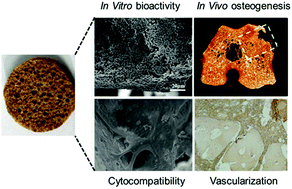Macro-mesoporous composites containing PEEK and mesoporous diopside as bone implants: characterization, in vitro mineralization, cytocompatibility, and vascularization potential and osteogenesis in vivo
Abstract
Bone implants of polyetheretherketone (PEEK) have become increasingly popular in the orthopedic field but its bioinertness and poor osteogenic properties significantly limit its applications for bone regeneration and osseointegration with host bone. In this study, by incorporation of mesoporous diopside (MD) into the PEEK matrix, macro-mesoporous PEEK/MD (PM) composites as bone implants with interconnected macropores of 300–400 μm were fabricated using the method of cold press-sintering and salt-leaching. The results showed that the compressive strength, porosity and water absorption of the porous PM composites significantly increased with an increase in the MD content. In addition, the incorporation of MD into PEEK obviously enhanced the mineralization ability of the PM composites, indicating good bioactivity. Moreover, the in vitro cell experiments indicated that the macro-mesoporous PM composites significantly promoted the adhesion and proliferation as well as osteogenic differentiation of MC3T3-E1 cells, which depended on the MD content. The results of synchrotron radiation-based micro-computed tomography (SRmCT) and histological analysis revealed that the porous PM composites possessed excellent osteogenic properties in vivo, which were obviously enhanced with an increase in the MD content. Moreover, the immunohistochemistry evaluation of type I collagen (COL I) and vascular endothelial growth factor (VEGF) confirmed that addition of MD into PEEK obviously enhanced the osteogenesis and vascularization potential of the macro-mesoporous PM composites in vivo. The results suggested that the PM composites containing macropores and mesopores as bone implants had great potential for bone repair/substitution.



 Please wait while we load your content...
Please wait while we load your content...